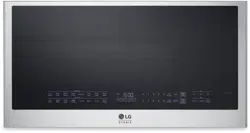Loading ...
Loading ...
Loading ...

29OPERATION
ENGLISH
• Heat-resistant plastic microwave cookware (safe
to 450°F) may be used, but is not recommended
for foods that require crusting or all-around
browning, because plastic is a poor conductor of
heat.
Cooking Guide
Cooking Tips
Carefully monitor the food in the microwave oven
while it is cooking. Directions given in recipes to
elevate, stir, etc., are the minimum steps
recommended. If food is overcooked (dry),
undercooked, or unevenly cooked, make
adjustments before or during cooking to correct
the problem.
• Overcooked or Dry Food
- Sprinkling: Sprinkle low-moisture foods such
as roasts and vegetables with water before
cooking, or cover them to retain moisture.
- Density: Light, porous food such as cakes and
breads cook more quickly than heavy, dense
foods such as roasts and casseroles.
- Shielding: Cover the corners of square dishes
with small strips of aluminum foil to prevent
overcooking. Don’t use too much foil, and
secure the foil to the dish. Foil can cause
arcing if it gets too close to the oven walls
during cooking.
- Bones and Fat: Bones conduct heat, and fat
cooks more quickly than meat. Take care with
bony or fatty cuts of meat.
• Undercooked Food
- Covering: Cover food with a microwave-safe
lid, parchment paper (not waxed paper), or
plastic wrap to trap heat and steam and cook
food more quickly.
- Standing Time: Let food stand for several
minutes after being removed from the oven to
allow it to finish cooking and help flavors blend
and develop.
- Quantity: The more food you place in the
oven, the longer the required cooking time.
- Temperature: Ice-cold ingredients take much
longer to cook than room temperature
ingredients.
• Unevenly Cooked Food
- Stirring: Stir food from the outside toward the
center during cooking, as food at the outside
of the dish heats more quickly.
- Arranging: Turn food over several times
during cooking. The upper portion of thick
foods cooks more quickly than the lower
portion.
- Shaping: Place the thickest portions of foods
like meat, poultry or fish toward the outside of
the cookware to help them cook more evenly.
If possible, shape foods into thin rounds or
rings.
• Foods with Skin, Shell or Membrane
- Skin or Membrane: Pierce the outsides of
foods like potatoes, sausages, or egg whites or
yolks before cooking.
- Shell: Pierce or remove the shells from eggs,
clams, oysters, or other shelled foods before
cooking.
• Defrosting Tips
- Remove fish, shellfish, meat, and poultry from
its original wrapping paper or plastic package.
Otherwise, the wrap close to the foods will
hold steam and heat, which can cause the
outer surface of the foods to be cooked.
- Remove any metal twist ties.
- Always slit or pierce plastic pouches or
packaging.
- Open containers such as cartons before they
are placed in the oven.
- If food is foil wrapped, remove foil and place
the food in a suitable container.
- The length of defrosting time varies
depending on the shape of the food and on
how solidly the food is frozen.
- As food begins to defrost, separate the food
into pieces so that they can defrost more
easily.
- Turn over food during defrosting or standing
time. Separate into pieces and remove food as
required.
- Let food stand after defrosting. Food should
still be somewhat icy in the center when
removed from the oven.
- When using Defrost, the weight to be entered
is the net weight in pounds and tenths of
pounds (the weight of the food minus the
container).
- Slit the skins of frozen food such as sausage.
- Bend plastic pouches of food to ensure even
defrosting.
- Place food in a shallow container or in a
microwave roasting dish to catch the
drippings.
- Always underestimate defrosting time. Food
should still be somewhat icy in the center
when removed from the oven. If defrosted
Loading ...
Loading ...
Loading ...
